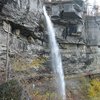New Scotland receives $50K to map natural resources
NEW SCOTLAND — New Scotland was recently awarded a $50,000 grant from the state that will allow the town to catalog its natural resources and come up with a plan for their future preservation.
The grant is funded by the state’s Environmental Protection Fund, which finances capital projects that protect the environment, and is administered by the Department of Environmental Conservation’s Hudson River Estuary Program.
The Hudson River Estuary Program covers a 153-mile stretch of water beginning at the Federal Lock and Dam in Troy and emptying into New York Harbor.
In her Oct. 26 announcement of the awards, Governor Kathy Hochul stated that 39 projects would receive a total of $1.5 million. The funds “will help communities along the Hudson River Estuary improve recreational access, enhance environmental education, and advance stewardship of natural resources,” the governor said.
When he was working on the application, Councilman Adam Greenberg, who spearheaded the initiative for the town, had been told receiving the funding might be a long shot because Hudson River Estuary Program grants are highly-sought after.
“So this was really great news,” he said.
The funding will allow the town to have all of its natural resources — or the ones it chooses to include, for example, its wetlands, streams, and viewsheds — accessible through interactive mapping, Greenberg said.
The mapping will give the town an accounting overview of its natural resources, he said, “What we have, where. And what we need to be aware of. Do we need to protect certain things? You know, is it OK to have development in a certain area?”
An open-space plan will follow the inventorying of the town’s resources.
The plan is a document that “outlines the desired goals for the future preservation and enhancement of both the natural and man-made resources which are important to the quality of life in a community,” according to one recently prepared local plan.
Explaining the resource inventory and subsequent mapping, Greenberg said that, if a resident or applicant to the planning or zoning boards had a question about a parcel of land, the property could be brought up on the mapping software to “see exactly what issues” the property “may or may not have.”
Greenberg said the mapping should streamline any application processes, in addition to being a new tool for the town’s building department.
He cited a hypothetical planning board example where an applicant has been before the board multiple times over the course of a number of months, but then somebody shows up late in the game and says, “But you have wetlands on the back 10 acres” of the property.
“That stuff would all come up as soon as an application” is submitted to the town, Greenberg explained.
“It’s really going to be an amazing step forward for the town in terms of being able to handle applications and getting information to residents and property owners,” he said.
Greenberg went on to explain that the interactive mapping could be used by someone looking to buy a property in town; it could aid the buyer in determining if the site has water issues. This has been information available to those who’ve needed it, Greenberg said, “but it might take a long time to find out.” Now it will be available with a few clicks.
The program is also an instance where the town is using its expanded planner position; Greenberg will be working with Nan Stolzenburg on the actual natural-resource inventory and open-space plan. But he’s also going to tap the state’s institutional knowledge for help as well.
Greenberg has lined up four or five New Scotland residents who have retired from careers at the DEC and have experience with mapping and resource inventorying and mapping, which is important when the town has to match state funding.
The grant has a 15-percent match, meaning New Scotland has to come up with $7,500 of the requested $50,000 to receive the financing.
But that $7,500 doesn’t have to be cash from the town. Rather, the DEC will accept “in-kind contributions [like] non-cash donations provided by non-state and/or non-federal third parties, which can include equipment, supplies, services, and other expendable property” — like, for example, the donated time of five retirees from the department.
As for a timeline, that’s to be determined, Greenberg said.



